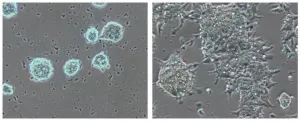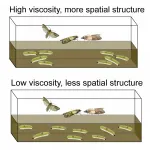Protein fingerprinting in minutes
New technology enables ultrafast identification of COVID-19 biomarkers
2021-03-25
(Press-News.org) Researchers from Charité - Universitätsmedizin Berlin and the Francis Crick Institute have developed a mass spectrometry-based technique capable of measuring samples containing thousands of proteins within just a few minutes. It is faster and cheaper than a conventional blood count. To demonstrate the technique's potential, the researchers used blood plasma collected from COVID-19 patients. Using the new technology, they identified eleven previously unknown proteins which are markers of disease severity. The work has been published in Nature Biotechnology*.
Thousands of proteins are active inside the human body at any given time, providing its structure and enabling reactions which are essential to life. The body raises and lowers the activity levels of specific proteins as required, including when responding to external factors such as pathogens and drugs. The detailed patterns of the proteins found inside cells, tissues and blood samples can therefore help researchers to better understand diseases or make diagnoses and prognoses. In order to obtain this 'protein fingerprint', researchers use mass spectrometry, a technology known to be both time-consuming and cost-intensive. 'Scanning SWATH', a new mass-spectrometry-based technology, promises to change this. Developed under the leadership of Prof. Dr. Markus Ralser, Director of Charité's Institute of Biochemistry, this technology, which is much faster and cost-effective than previous methods, enables researchers to measure several hundred samples per day.
"In order to speed up this technology, we changed the mass spectrometer's electric fields. The data produced are of such extreme complexity that humans can no longer analyze them," explains Einstein Professor Prof. Ralser, who is also a Group Leader at the Francis Crick Institute in London. He adds: "We therefore developed computer algorithms that are based on neural networks and which use these data to extract the relevant biological information. This enables us to identify thousands of proteins in parallel and greatly reduces measuring timescales. Fortunately, this method is also more precise."
This high-throughput technology has a broad range of potential applications, ranging from basic research and large-scale drug development to the identification of biological markers (biomarkers), which can be used to estimate an individual patient's risk. The technology's suitability for the latter was demonstrated by the researchers' study on COVID-19. As part of this research, the team analyzed blood plasma samples from 30 Charité inpatients with COVID-19 of varying degrees of disease severity, comparing the protein patterns obtained with those of 15 healthy individuals. The actual measurements conducted on individual samples only took a few minutes.
The researchers were able to identify a total of 54 proteins whose serum levels varied according to the severity of COVID-19. While 43 of these proteins had already been linked to disease severity during earlier studies, no such relationship had been established for 11 of the proteins identified. Several of the previously unknown proteins associated with COVID-19 are involved in the body's immune response to pathogens which increases clotting tendency. "In the shortest of timeframes, we discovered protein fingerprints in blood samples which we are now able to use to categorize COVID-19 patients according to severity of disease," says one of the study's lead authors, Dr. Christoph Messner, who is a researcher at Charité's Institute of Biochemistry and the Francis Crick Institute. He continues: "This type of objective assessment can be extremely valuable, as patients will occasionally underestimate the severity of their disease. However, in order to be able to use mass spectrometry analysis for the routine categorization of COVID-19 patients, this technology will need to be refined further and turned into a diagnostic test. It may also become possible to use rapid protein pattern analysis to predict the likely course of a case of COVID-19. While the initial findings we have collected are promising, further studies will be needed before this can be used in routine practice."
Prof. Ralser is convinced that mass spectrometry-based investigations of the blood could one day complement conventional blood count profiles. "Proteome analysis is now cheaper than a complete blood count. By identifying many thousands of proteins at the same time, proteomic analysis also produces far more information. I therefore see enormous potential for widespread use, for instance in the early detection of diseases. We will therefore continue to use our studies to develop proteome technology for this type of application."
INFORMATION:
*Messner CB et al. Ultra-fast proteomics with Scanning SWATH. Nat Biotech (2021). DOI: 10.1038/s41587-021-00860-4
About the study
The study is the result of a collaboration with the University of Cambridge, United Kingdom, the Chalmers University of Technology, Sweden, the Bernhardt Nocht Institute for Tropical Medicine in Hamburg, Germany, and SCIEX, a Canadian manufacturer of mass spectrometers.
Mass spectrometry
Mass spectrometry is an analytical technique used to measure the mass of molecules and atoms. The substance to be analyzed is first converted into gas-phase molecules which are subsequently converted into ions. Once accelerated to high velocity by an electrical field, these ions are then sorted by the mass spectrometer system's analyzer and separated according to their mass/charge ratios. The resulting mass spectrum provides information on a substance's molecular composition. Mass spectrometry is suitable for the identification, characterization and quantification of a myriad of biomolecules such as proteins, metabolites, sugars and fats, all of which behave differently depending on the precise clinical picture which manifests in a particular patient.
Proteomics platform to study COVID-19 at Charité
The data underpinning the published article were generated using the Pa-COVID-19 platform. Pa-COVID-19 is a prospective registry study for patients with COVID-19 at Charité. The aim of the registry is to collate comprehensive clinical and molecular data on patients with COVID-19 in order to identify individual risk factors for severe disease, as well as prognostic biomarkers and treatment targets. The protocol for the study is available here: https://link.springer.com/article/10.1007/s15010-020-01464-x
[Attachments] See images for this press release:

ELSE PRESS RELEASES FROM THIS DATE:
2021-03-25
Expectant women are more likely to give birth early if they have high blood levels of a chemical used in flame retardants compared with those who have limited exposure, a new study finds.
These polybrominated diphenyl ethers (PBDEs) are used in the manufacture of furniture, carpeting, and other products to reduce flammability. Previous studies have found that the substances can leach into household dust and build up in the body where they may interfere with the thyroid, an organ that secretes brain-developing hormones. Childhood exposure to PBDEs has been linked to learning disabilities, autistic ...
2021-03-25
Millions of years ago, aphid-like insects called whiteflies incorporated a portion of DNA from plants into their genome. A Chinese research team, publishing March 25th in the journal Cell, reveals that whiteflies use this stolen gene to degrade common toxins plants use to defend themselves against insects, allowing the whitefly to feed on the plants safely.
"This seems to be the first recorded example of the horizontal gene transfer of a functional gene from a plant into an insect," says co-author Ted Turlings (@FARCE_lab), a chemical ecologist and entomologist ...
2021-03-25
Octopuses are known to sleep and to change color while they do it. Now, a study publishing March 25 in the journal iScience finds that these color changes are characteristic of two major alternating sleep states: an "active sleep" stage and a "quiet sleep" stage. The researchers say that the findings have implications for the evolution of sleep and might indicate that it's possible for octopuses to experience something akin to dreams.
Scientists used to think that only mammals and birds had two sleep states. More recently, it was shown that some reptiles also show non-REM and REM sleep. A REM-like sleep state was reported ...
2021-03-25
More than half of the opioid tablets prescribed for patients who underwent orthopaedic or urologic procedures went unused in a new study by researchers at the Perelman School of Medicine at the University of Pennsylvania. Using an automated text messaging system that regularly checked in with patients on their pain and opioid use, the study also showed that most opioids are taken within the first few days following a procedure and may not be necessary to manage pain even just a week following a procedure. The study was published today in JAMA Network Open.
"Through simple text messaging we highlight a method which gives clinicians the information they need to reduce prescribing and manage ...
2021-03-25
BOSTON - In the largest study of its kind to date, researchers at Massachusetts General Hospital, Brigham and Women's Hospital and the Ragon Institute of MGH, MIT and Harvard have found the new mRNA COVID-19 vaccines to be highly effective in producing antibodies against the SARS-CoV-2 virus in pregnant and lactating women. They also demonstrated the vaccines confer protective immunity to newborns through breastmilk and the placenta.
The study, published in the American Journal of Obstetrics and Gynecology (AJOG), looked at 131 women of reproductive age (84 pregnant, 31 lactating and 16 non-pregnant), ...
2021-03-25
Chronic side effects among melanoma survivors after treatment with anti-PD-1 immunotherapies are more common than previously recognized, according to a study published March 25 in JAMA Oncology.
The chronic complications, which occurred in 43% of patients, affected the joints and endocrine system most commonly, and less often involved salivary glands, eyes, peripheral nerves and other organs. These complications may be long lasting, with only 14% of cases having been resolved at last follow-up. This finding contrasted with previously reported immunotherapy-related acute complications that affected visceral organs -- including the liver, colon, lungs and kidneys -- which were effectively treated with steroids. However, the vast ...
2021-03-25
Pregnant women who consumed the caffeine equivalent of as little as half a cup of coffee a day on average had slightly smaller babies than pregnant women who did not consume caffeinated beverages, according to a study by researchers at the National Institutes of Health. The researchers found corresponding reductions in size and lean body mass for infants whose mothers consumed below the 200 milligrams of caffeine per day--about two cups of coffee--believed to increase risks to the fetus. Smaller birth size can place infants at higher risk of obesity, heart ...
2021-03-25
Scientists at the Proteomics Core Unit of the Spanish National Cancer Research Centre (CNIO), headed by Javier Muñoz, have described the mechanisms, unknown to date, involved in maintaining embryonic stem cells in the best possible state for their use in regenerative medicine. Their results, published in Nature Communications, will help to find novel stem-cell therapies for brain stroke, heart disease or neurodegenerative conditions like Alzheimer's or Parkinson's disease.
Naïve pluripotent stem cells, ideal for doing research
Embryonic stem cells (ESCs) are pluripotent cells that can grow ...
2021-03-25
Quantum holds the promise of increasing the power of sensing technologies. While the field of quantum sensing has shown a lot of potential for detecting very small signals, the ability to truly optimize these sensors has been thwarted by the complexity of control schemes.
In a paper published on March 25 in Nature Partner Journals - Quantum Information, a research team based at the Johns Hopkins University Applied Physics Laboratory (APL) in Laurel, Maryland, explained how they applied two theoretical tools of quantum information to these types of extremely sensitive signal detection tasks. Their research suggests that honing this sensitivity to detect signals while rejecting background noise will enable the use of quantum ...
2021-03-25
HOUSTON - (March 25, 2021) - One of nature's most prolific cannibals could be hiding in your pantry, and biologists have used it to show how social structure affects the evolution of selfish behavior.
Researchers revealed that less selfish behavior evolved under living conditions that forced individuals to interact more frequently with siblings. While the finding was verified with insect experiments, Rice University biologist Volker Rudolf said the evolutionary principal could be applied to study any species, including humans.
In a study published online this week in Ecology Letters, Rudolf, longtime collaborator Mike Boots of the University of California, Berkeley, and colleagues showed they could drive the evolution of cannibalism in ...
LAST 30 PRESS RELEASES:
[Press-News.org] Protein fingerprinting in minutes
New technology enables ultrafast identification of COVID-19 biomarkers



